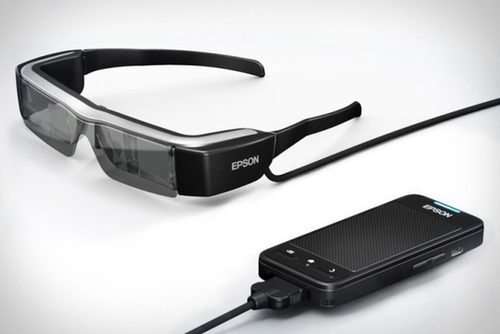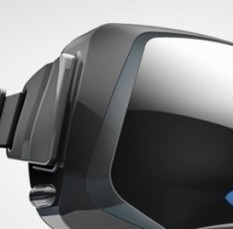Mag 15, 2014 | News on Augmented, Mixed and Virtual Reality
See on Scoop.it – augmented world

The wearable technology field is continuing to heat up with more and more companies entering it. One of those companies happens to be Epson, who has already made a foray into the world of smart glasses with the Moverio BT-100 smart glasses. Now Epson’s back with the Moverio BT-200 smart glasses, a new and improved version of its smart glasses. You probably haven’t heard of them so let’s rundown some of their highlights.
augmented world‘s insight:
The BT-200s feature a full projected display that spans across both lenses, as well as a variety of sensors and a front-facing camera for motion tracking and augmented reality applications. The glasses are also 60% lighter than their predecessor and are also smaller, for improved comfort. Nonetheless, they still look quite nerdy to wear. But what these glasses have over many competitors is that they’re not only able to project over your entire vision, but they also have inserts for different shading, as with sunglasses, and inserts for prescription lenses.
While they’re obviously not for everyone, the BT-200s pack a lot of function. One of the downsides is that they do require the included controller for full functionality. Good news is that these glasses are less than half the price of Google Glass, at just $699. If you’re okay with having a separate control unit and not having the sleekest look, these could be an interesting option. Hit up the source link for more info and purchasing.
See on androidandme.com
Mag 15, 2014 | News on Augmented, Mixed and Virtual Reality
See on Scoop.it – augmented world

Oculus è una delle ultime aziende acquisite da Facebook. L’acquisto ha fatto sicuramente meno notizia di quello di Whatsapp, la popolare App di messaggistica per smartphone, ma i suoi risvolti potrebbero essere decisamente più importantiper il mondo della tecnologia.
augmented world‘s insight:
In una recente intervista infatti Brendan Iribe, CEO di Oculus anche dopo l’acquisizione, avrebbe puntato nella direzione dei mondi virtuali in stile Second Life / World of Warcraft, idee forse un po’ vecchie che però potrebbero trovare nuova vita proprio grazie alle periferiche sviluppate da Oculus e dall’enorme numero di iscritti al social network di Mark Zuckerberg.
Oculus infatti produce degli strani visori, che vanno indossati come se fossero degli occhiali, che sono in grado di proiettare immagini da fruire in prima persona, dispositivi che sono già straordinari per quei videogiochi in prima persona e che potrebbero essere il dispositivo che farà fare il salto definitivo ai mondi virtuali.
Ed è proprio per questo motivo, e per il miliardo e rotti di iscritti a Facebook, che Oculus starebbe pensando di mettere in piedi un enorme mondo virtuale in stile World of Warcraft, una esperienza totalizzante dove si potrà vivere un’autentica seconda vita, compiendo anche, ed è quello che interessa a Facebook, acquisti e fruizione di contenuti a pagamento.
Un progetto che però sembra ancora lontano, in quanto, secondo il CEO di Oculus, non ci sarebbero ancora reti sufficientemente prestanti per ospitare un miliardo di utenti collegati ad un mondo del genere. "Non ancora", ha detto. Ma intanto ai piani alti di Facebook si lavora per scollegare noi utenti, una volta per tutte, dalla vita reale.
See on news.supermoney.eu
Mag 15, 2014 | News on Augmented, Mixed and Virtual Reality
See on Scoop.it – augmented world

No, non è ancora la tastiera di Tom Cruise in Minority Report, ma la strada potrebbe essere quella. Almeno stando a quanto racconta un video rilasciato dalla neonata divisione Special Projects di Microsoft, affidata alle sapienti mani di Norman A. Whitaker, ex direttore dell’Information Innovation Office della DARPA e, fra l’altro, ex CEO dell’Escher Research Institute. La nomina è stata ufficializzata da poco, così come la creazione della nuova unità, che si pone dunque in diretta competizione con Google X nel lavorare su “progetti con obiettivi volti a modificare e ad ampliare ciò che la gente immagina sia possibile ottenere con la tecnologia”.
See on www.wired.it
Mag 15, 2014 | News on Augmented, Mixed and Virtual Reality
See on Scoop.it – augmented world
Google’s ambitious augmented reality glasses, called Glass, has yet to receive an official release date, but information concerning the new features of these glasses is beginning to emerge. Google has high hopes for its AR glasses, believing that the product will help people see and interact with the world around them in a different way by blurring the boundaries that separate the digital and physical worlds. Like other high-tech gadgets, however, Glass will consume a significant amount of electrical power in order to accomplish this goal. Solar energy may be the key to satisfying Glass’ power needs.
augmented world‘s insight:
AR glasses gaining notoriety for their energy consumption
Glass will be equipped with many of the features that have come to define smartphones and other mobile devices. Glass users will be able to make calls from their AR glasses as well as send text messages. They will also be able to access a wide range of third-party applications and those developed by Google specifically for the Glass platform. The device’s more energy-intensive features, such as video recording and streaming, may require a somewhat innovative energy solution in order to satisfy the needs of consumers.
Early adopters make use of small solar panels
Those with Explorer editions of Glass — primarily developers that purchased early access to the platform — are beginning to turn to solar energy in order to resolve some of the energy problems that Glass has. Glass is quite small, meaning that it has limited space to fit a long-lasting lithium-ion battery, thus limiting how long the device can be used. Because Glass is often worn outside, it is exposed to sunlight on a regular basis, which is ideal when attempting to power the device using solar energy. Early adopters are equipping Glass with small solar panels that can produce enough electrical power to keep Glass charged for several hours, even after the device’s battery has been exhausted.
See on www.hydrogenfuelnews.com
Mag 15, 2014 | News on Augmented, Mixed and Virtual Reality
See on Scoop.it – augmented world

Sony ha dimostrato di voler puntare tantissimo su Project Morpheus, il visore per la Realtà Virtuale presentato qualche settimana fa, e far coincidere il tutto con l’interesse volto a spingere il mercato indipendente. Infatti, metà delle risorse destinate alla tecnologia è tutta indirizzata verso gli indie. Lo ha detto Agostino Simonetta, responsabile delle pubbliche relazioni con publisher e sviluppatori per Sony Computer Entertainment Europe.
See on www.everyeye.it




